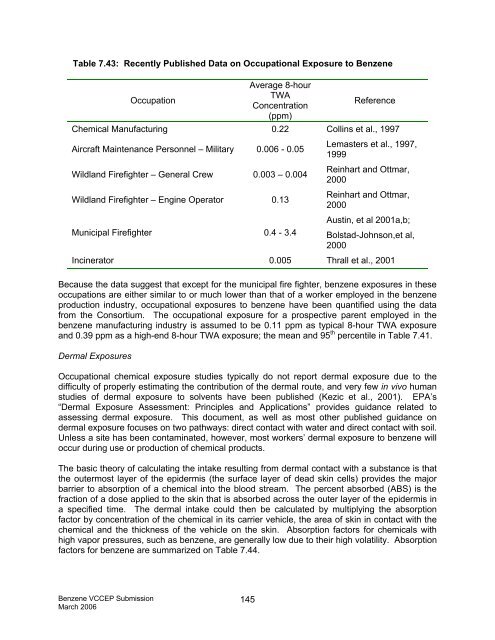(VCCEP) Tier 1 Pilot Submission for BENZENE - Tera
(VCCEP) Tier 1 Pilot Submission for BENZENE - Tera
(VCCEP) Tier 1 Pilot Submission for BENZENE - Tera
Create successful ePaper yourself
Turn your PDF publications into a flip-book with our unique Google optimized e-Paper software.
Table 7.43: Recently Published Data on Occupational Exposure to Benzene<br />
Occupation<br />
Benzene <strong>VCCEP</strong> <strong>Submission</strong><br />
March 2006<br />
145<br />
Average 8-hour<br />
TWA<br />
Concentration<br />
(ppm)<br />
Reference<br />
Chemical Manufacturing 0.22 Collins et al., 1997<br />
Aircraft Maintenance Personnel – Military 0.006 - 0.05<br />
Wildland Firefighter – General Crew 0.003 – 0.004<br />
Wildland Firefighter – Engine Operator 0.13<br />
Lemasters et al., 1997,<br />
1999<br />
Reinhart and Ottmar,<br />
2000<br />
Reinhart and Ottmar,<br />
2000<br />
Municipal Firefighter 0.4 - 3.4<br />
Austin, et al 2001a,b;<br />
Bolstad-Johnson,et al,<br />
2000<br />
Incinerator 0.005 Thrall et al., 2001<br />
Because the data suggest that except <strong>for</strong> the municipal fire fighter, benzene exposures in these<br />
occupations are either similar to or much lower than that of a worker employed in the benzene<br />
production industry, occupational exposures to benzene have been quantified using the data<br />
from the Consortium. The occupational exposure <strong>for</strong> a prospective parent employed in the<br />
benzene manufacturing industry is assumed to be 0.11 ppm as typical 8-hour TWA exposure<br />
and 0.39 ppm as a high-end 8-hour TWA exposure; the mean and 95 th percentile in Table 7.41.<br />
Dermal Exposures<br />
Occupational chemical exposure studies typically do not report dermal exposure due to the<br />
difficulty of properly estimating the contribution of the dermal route, and very few in vivo human<br />
studies of dermal exposure to solvents have been published (Kezic et al., 2001). EPA’s<br />
“Dermal Exposure Assessment: Principles and Applications” provides guidance related to<br />
assessing dermal exposure. This document, as well as most other published guidance on<br />
dermal exposure focuses on two pathways: direct contact with water and direct contact with soil.<br />
Unless a site has been contaminated, however, most workers’ dermal exposure to benzene will<br />
occur during use or production of chemical products.<br />
The basic theory of calculating the intake resulting from dermal contact with a substance is that<br />
the outermost layer of the epidermis (the surface layer of dead skin cells) provides the major<br />
barrier to absorption of a chemical into the blood stream. The percent absorbed (ABS) is the<br />
fraction of a dose applied to the skin that is absorbed across the outer layer of the epidermis in<br />
a specified time. The dermal intake could then be calculated by multiplying the absorption<br />
factor by concentration of the chemical in its carrier vehicle, the area of skin in contact with the<br />
chemical and the thickness of the vehicle on the skin. Absorption factors <strong>for</strong> chemicals with<br />
high vapor pressures, such as benzene, are generally low due to their high volatility. Absorption<br />
factors <strong>for</strong> benzene are summarized on Table 7.44.





